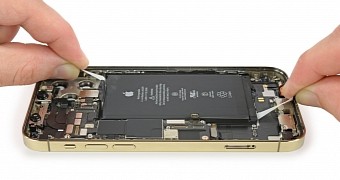We’ve known for a while Apple isn’t the biggest fan of large batteries on its smartphones, and the company would rather heavily optimize its operating system rather than go for a larger pack.
And it’s not me saying this, but the actual numbers showing just small are the batteries available on the iPhone, all as compared to the ones on Android devices.
Here are a few figures so you can get a better bigger of the whole thing:
- Samsung Galaxy Note20 Ultra – 4,500 mAh
- iPhone 12 – 2,815 mAh
- iPhone 12 Pro Max – 3,687 mAh
So theoretically, Apple has always focused a lot more on optimizing the operating system and the apps running on the iPhone, and thus offer smaller batteries on its devices. This obviously comes with several benefits, as it makes it possible for the company to make iPhones smaller and thinner.
Just think that iPhone SE, a device that launched in 2020, comes with a 1,821 mAh battery, while smartphones in the Android ecosystem are already breaking the 5,000 mAh barrier.
Aaaand, as if this wasn’t already enough, it looks like Apple wants the batteries that it uses on the iPhone to be even smaller – not smaller in physical dimensions, but smaller in the actual capacity that it offers to users.
This is according to recent analyst information, which suggests that Apple wants to use battery soft boards for the iPhone 13 and iPhone 13 mini. So theoretically, at least two of the four iPhones launching next year could come with these smaller batteries, if this report is accurate.
The battery soft boards include fewer layers, and this means they are also smaller in dimensions, which means Apple itself can use the extra space for other purposes, such as improving the design of the smartphone. For now, it’s not yet clear what direction the company wants to embrace, but with this battery strategy, there’s a chance iPhone 13 would bring several surprises in this regard.
As you probably know already, batteries are a complicated topic for Apple, as the company has previously been accused of slowing down iPhones on purpose because of degraded batteries. The firm said it only did this in an attempt to prevent unexpected shutdowns caused by aged batteries.
“As lithium-ion batteries chemically age, the amount of charge they can hold diminishes, resulting in shorter amounts of time before a device needs to be recharged. This can be referred to as the battery’s maximum capacity—the measure of battery capacity relative to when it was new. In addition, a battery’s ability to deliver maximum instantaneous performance, or “peak power,” may decrease,” Apple explains in a technical analysis of why a battery management function is required.
“In order for a phone to function properly, the electronics must be able to draw upon instantaneous power from the battery. One attribute that affects this instantaneous power delivery is the battery’s impedance. A battery with a high impedance may be unable to provide sufficient power to the system that needs it. A battery's impedance can increase if a battery has a higher chemical age. A battery’s impedance will temporarily increase at a low state of charge and in a cold temperature environment. When coupled with a higher chemical age, the impedance increase will be more significant. These are characteristics of battery chemistry that are common to all lithium-ion batteries in the industry.”
iPhone 13 is projected to go live in the fall of the next year, and it’s believed the new generation would include upgrades for all models launched this year. However, the lineup would remain mostly the same, with bigger changes planned for 2022 when a foldable iPhone could also see daylight.

 14 DAY TRIAL //
14 DAY TRIAL //